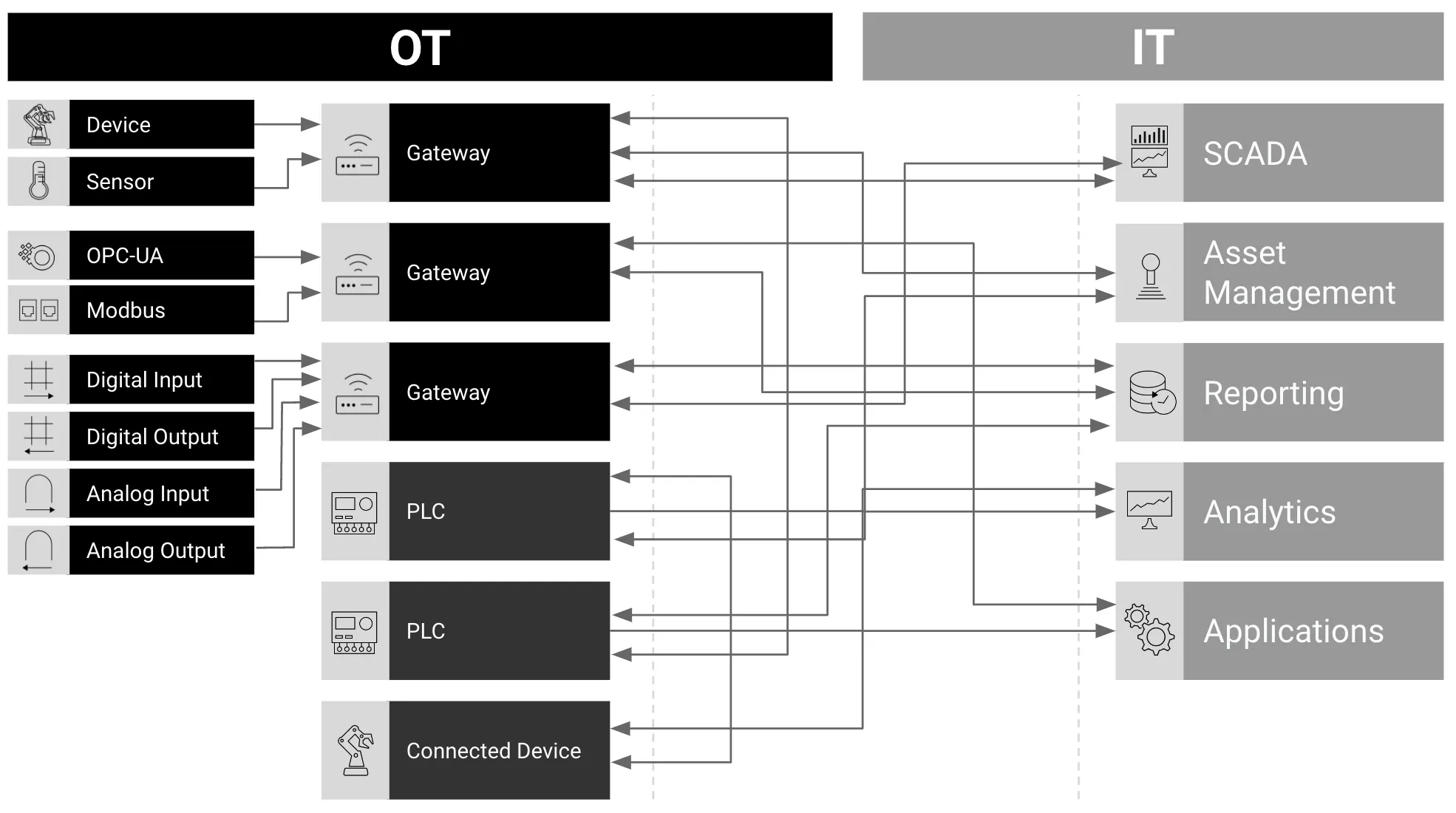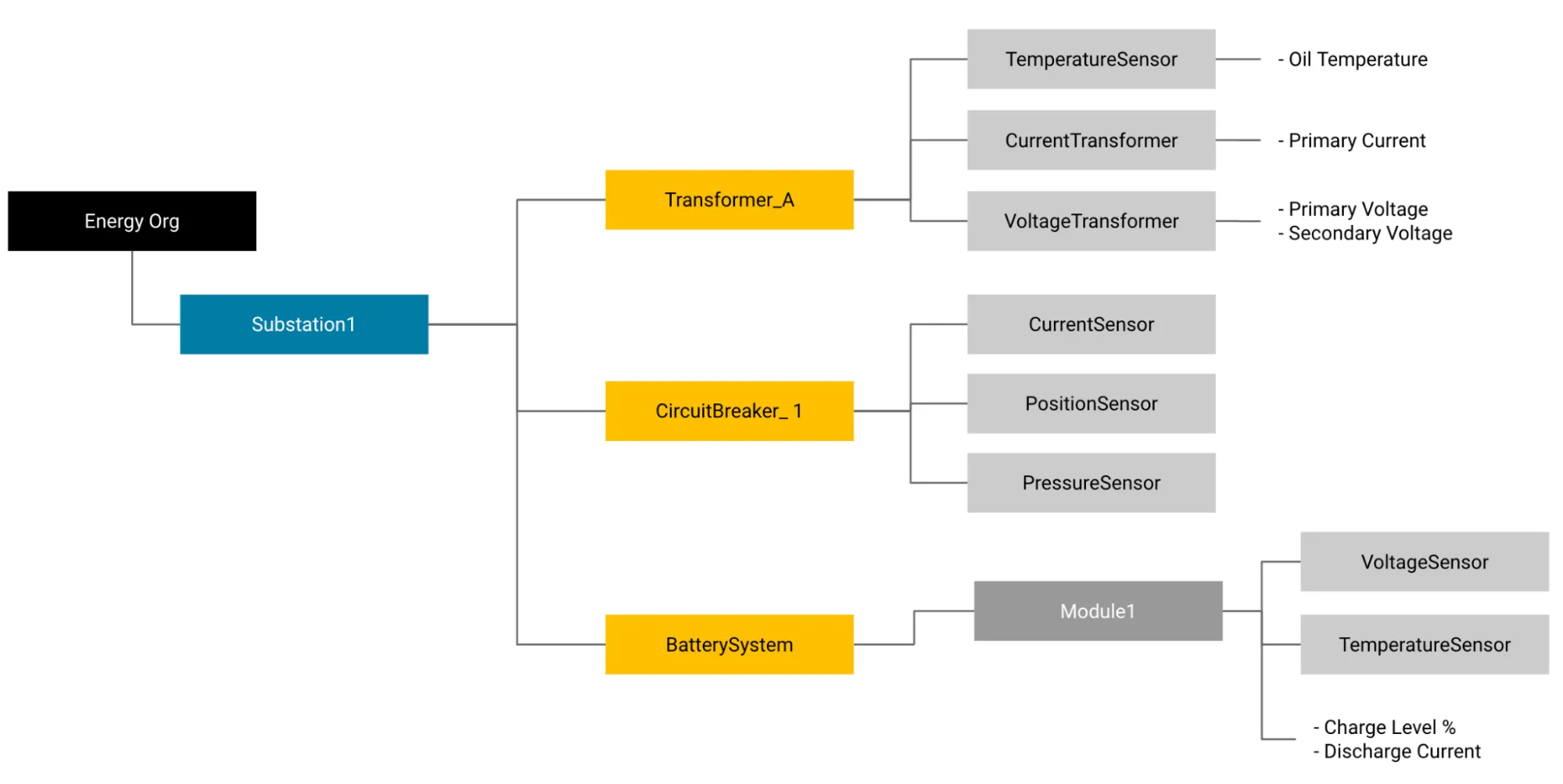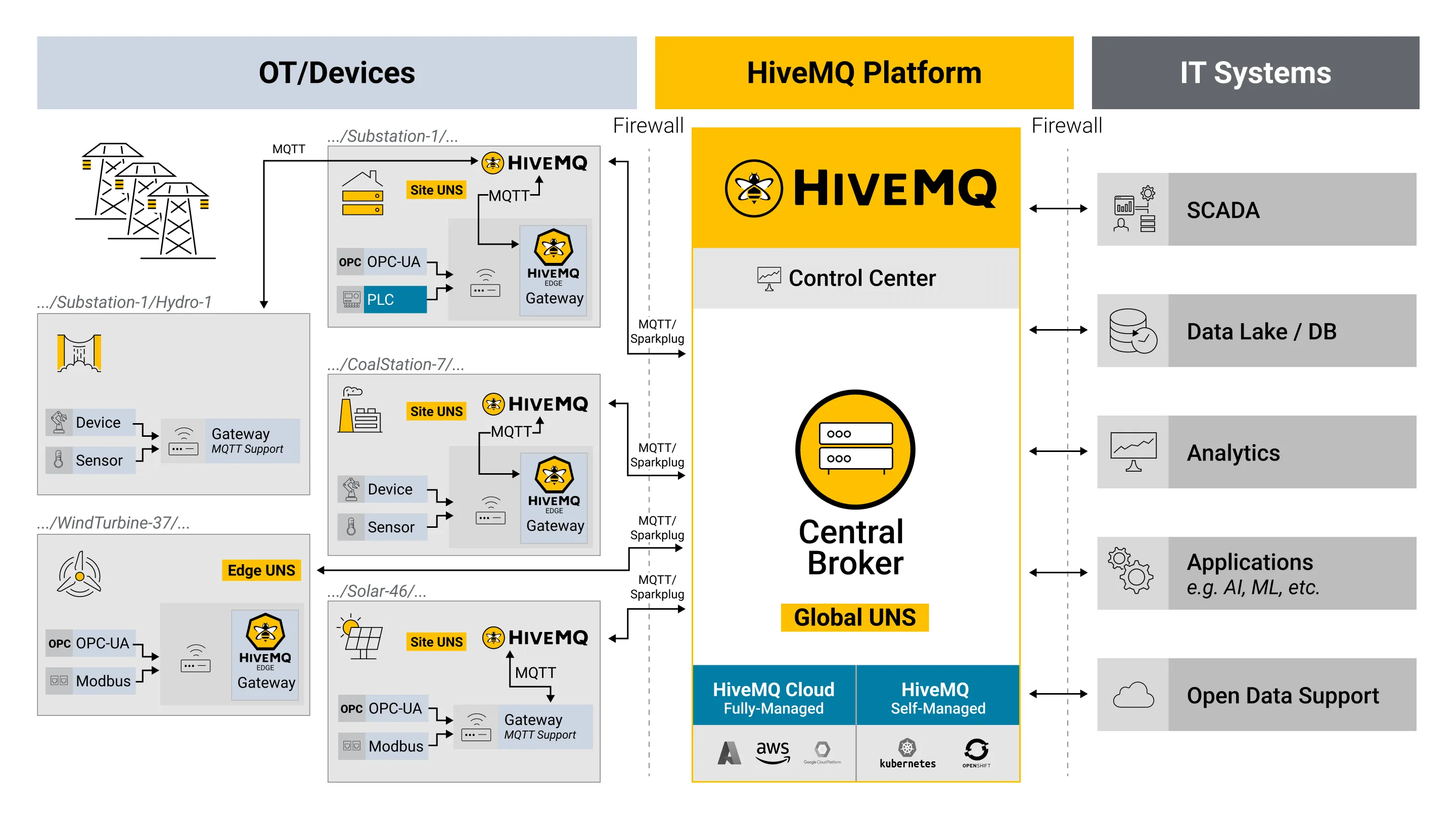IT-OT Convergence and Data Interoperability in Utilities with Unified Namespace
In most energy utility networks, there's a wide range of equipment of various ages and protocol standards. Each does a critical job whilst connectivity is mainly focused on alarm and device management. In most cases, however, they have limited ability to extract data, and where they do, proprietary solutions are often put in place to service very specific, siloed use cases. Companies end up spending large sums of money every time a new use case is identified and required (usually regulator driven).
This patchwork of solutions ends up increasing costs further as new use cases become difficult, complicated and long to implement, adding risk to the business as you can see in the diagram below. Architecture diagrams of data interconnectivity end up looking like spaghetti with lines crossing lines to describe the intricate networks of connection to support various needs in the business. This drastically affects agility and makes initiatives such as digital transformation and whole system visibility extremely difficult, complicated, and expensive.
 The simple end goal should be to create a single, unified version of the truth of the current state of your operations network. A central place that your developers can go to where they can easily understand and create use cases that rely on knowing the current state of any device on the network. Achieving this however appears to be an impossible dream for many Utility networks, only realized many years into the future.
The simple end goal should be to create a single, unified version of the truth of the current state of your operations network. A central place that your developers can go to where they can easily understand and create use cases that rely on knowing the current state of any device on the network. Achieving this however appears to be an impossible dream for many Utility networks, only realized many years into the future.
This spaghetti architecture places a huge risk on Utility networks in the quest to achieve Net Zero carbon emissions because Net Zero will rely on leveraging smart technologies such as Artificial Intelligence (AI), that requires access to accurate, up-to-date and complete data about the network. The problem is not a new one. Manufacturing has been grappling with this issue for some time. The problem stems from the use of equipment and interconnectivity standards that are great for what they were designed for, controlling processes but not digital transformation.
A variety of systems and standards such as Supervisory Control and Data Acquisition (SCADA), Modbus, OPC UA, as well as different Programmable Logic Controller (PLC) systems, are often found in many operational technology setups. While each of these systems is good in local or siloed command and control, a unified way to digitally monitor, control, and get visibility of your infrastructure is missing.
The Problem of Unifying Data in Utilities
How can you bring all of these systems and standards together to create a single version of the truth of their current state?
Data Lakes/Data Warehouses
These are popular choices for many Utilities. The ease of connecting devices into the cloud cannot be overstated. Cloud technologies have been game-changing in their ability to connect disparate systems and devices together. The problems begin, however, when you consider two key attributes: current state and cost.
Achieving a current state model is possible, but scale becomes an acute issue, as does security. Connecting your operational technology securely to the cloud when it underpins critical national infrastructure is not for the faint of heart and requires a significant level of scrutiny from your OT and Cybersecurity teams.
Add to this the inherent latency in cloud data lakes, the additional need for data processing and governance, as well as the cost for compute, storage, and transfer of data creates its own problems in terms of reliance. For more information, read my colleague's blog on why a data warehouse cannot be the unified namespace.
Cloud platforms most definitely have their place and can be super valuable in helping you to understand hindsight and foresight, however for understanding insight in real-time, it can be problematic without the right architecture.
Unified Namespace – Your “Data Digital Twin”
A Unified Namespace or UNS as it is commonly referred to, has been popularized by Industry 4.0 thinkers and influencers such as Walker Reynolds and Kudzai Manditereza.
A UNS is a single version of the truth, of the current state of your business. Essentially it’s a data structure that models your physical asset infrastructure along with all connected devices and any associated attributes. Think of it as a “data digital twin” of your business.
 This digital data twin is connected to your asset infrastructure and maintained in a message broker, which enables applications, systems, and services to communicate with each other in real-time and exchange information. The concept has been mainly talked about and implemented to support Industry 4.0 projects in manufacturing, which involve the integration of intelligent digital technologies into manufacturing and industrial processes.
This digital data twin is connected to your asset infrastructure and maintained in a message broker, which enables applications, systems, and services to communicate with each other in real-time and exchange information. The concept has been mainly talked about and implemented to support Industry 4.0 projects in manufacturing, which involve the integration of intelligent digital technologies into manufacturing and industrial processes.
Manufacturers have the same problem as utility networks, with one subtle exception, their operational assets are generally concentrated in specific locations, their factories. These factories can be, however, highly distributed across different geographical locations. In the manufacturer's case, agility is critical. They need to constantly assess the efficiency and effectiveness of their production processes to solve production line issues quickly or before they happen, and react quickly to changes in demand.
Manufacturers that have successfully integrated their Operations Technology (OT) to Information Technology (IT) and achieved Industry 4.0 levels of operation have shown improvements of more than 89% faster time to market, an over 250% increase in productivity, and a whopping 97% reduction in CO2 emissions, according to McKinsey’s Global Lighthouse Network of 132 Lighthouse sites on performance improvements from Industry 4.0 initiatives.
Start with the Data
A UNS forms the foundation for any modern Industry 4.0 or OT-driven digital transformation initiative, starting with the data.
You cannot make decisions, automate, or make use of AI on data that is not clean, current, complete, and in the right context.
The UNS makes use of the lightweight, device agnostic, and robust standard, MQTT to interconnect devices into a single logical view, the central component of which, the software broker, becomes the focal point for the UNS. MQTT is a well-developed, governed, and proven standard for publish-subscribe, asynchronous message-based device communication, originally invented at IBM in the late 1990s for communication with remote devices in hostile locations in the Oil & Gas industry.
The essence of an MQTT message is the topic, a string that typically describes and identifies both the device and attributes of the device; and the payload, an attribute of up to 256Mb in length which carries the associated data describing the current state.
Devices and systems establish connections to the MQTT broker and can publish messages to it, and subscribe to topics to receive update messages. The broker manages the communications and maintains the current state organized using the topic structure.
The broker is a critical component in the UNS architecture. To properly serve the business, the broker you choose needs to address 4 key factors:
Reliability - If the broker's unavailable, there's no current state to see. You need a broker that mitigates single-point-of-failure. Choose a proven enterprise-grade broker that uses a masterless cluster architecture built for resilience and fail-safe.
Zero Data Loss - If your devices are sending critical data that never arrives, huge risk ensues. The MQTT standard defines a method called Quality of Service (QoS), from fire and forget to guaranteed delivery of messages. Choose an enterprise-grade broker that fully implements all aspects of the MQTT standard.
Scalability - Your network could potentially send hundreds or even thousands of messages every second from many thousands of devices. Choose a broker that is architected, tested, and proven to provide elastic scalability whatever the demand and volume from your network.
Security - Security is critical, not just between all of the connecting points, but also in terms of who can see what data in the UNS. Choose a broker that supports the latest in OT cybersecurity technology, maintains current and full security accreditation and certification, and provides role-based access to the UNS data.
The UNS also recognizes that co-location and no single point of failure can be critical to the architecture, so having a broker that can build the UNS at a location, regional, or functional level, and feed up to a central or HQ broker further enables you to achieve redundancy and flexibility in your UNS architecture.
 Finally, the UNS doesn't work unless you can connect it to the devices themselves, and as mentioned at the very start, not all devices provide the same level of support. Clearly in some networks, older devices require updating, however using an edge software platform that enables fast and reliable translation from SCADA protocols to MQTT completes the UNS without massive, and in many cases, any changes to your existing OT network.
Finally, the UNS doesn't work unless you can connect it to the devices themselves, and as mentioned at the very start, not all devices provide the same level of support. Clearly in some networks, older devices require updating, however using an edge software platform that enables fast and reliable translation from SCADA protocols to MQTT completes the UNS without massive, and in many cases, any changes to your existing OT network.
In addition to that, there is a need for data hub software that ensures that the data coming from the various systems are standardized, transformed, and contextualized so that UNS can use it to support the various data use cases, including AI and others.
Advantages of Implementing Unified Namespace in Utilities
Implementing a UNS significantly reduces your OT-IT use case development time and effort, giving you a huge increase in productivity. A recent McKinsey report found that 74% of digital transformation projects are stuck in the pilot phase. The reason is apparent: many companies treat digital transformation as a series of isolated, siloed projects. With UNS you can realize an overall increase in Digital Transformation success and ROI, and reduced risk.
UNS gives you a clear runway to take advantage of AI to improve the efficiency and agility of your operations… “You are what you eat” when it comes to AI! Data accuracy is critical to delivering responsible AI. In the future, it’s likely that C-level leadership will carry legal responsibility to ensure that responsible AI practices include understanding and monitoring the training datasets for AI deployments.
Yet, according to a recent MIT Technology Review survey, 57% of executives said that AI use cases are hampered by inadequate data quality. Only about one in five companies surveyed have production assets with data ready for use in existing AI models.
Conclusion
Achieving whole system visibility by connecting your asset data together into a single, unified, and real-time view appears to be a complex and difficult task.
However, the Unified Namespace enabled by a robust and proven IoT platform like HiveMQ is already solving these challenges at large multinational manufacturers such as Mercedes, and at many Energy and Utility Networks such as Anglian Water and Norway's Fortum Energy.
Come and talk to HiveMQ about how we can help you to achieve whole system visibility, lower your development costs and reduce your digital transformation risks with our Enterprise-grade broker platform.

Sean Crouch
Sean is an Enterprise Account Executive at HiveMQ, with a wealth of experience spanning more than 30 years in IT and Technology. He's a former Software and Solutions Engineer, and has spent the last 6 years focused on providing data solutions to drive digital transformation in the Manufacturing, Energy and Utilities sectors. Sean leads HiveMQ's business in the UK helping enterprises to accelerate transformative business outcomes with the Unified Namespace and MQTT.
